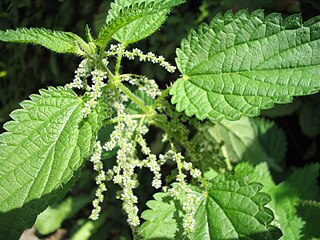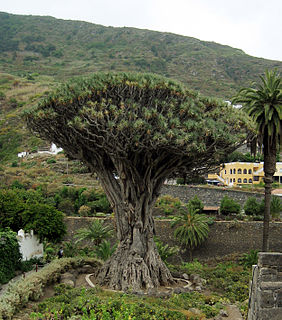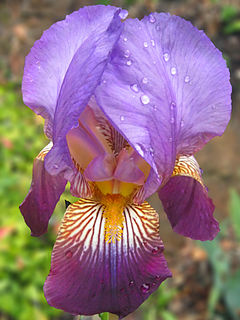
Aloe, also written Aloë, is a genus containing over 550 species of flowering succulent plants. The most widely known species is Aloe vera, or "true aloe". It is called this because it is cultivated as the standard source for assorted pharmaceutical purposes. Other species, such as Aloe ferox, are also cultivated or harvested from the wild for similar applications.

Buddleja is a genus comprising over 140 species of flowering plants endemic to Asia, Africa, and the Americas. The generic name bestowed by Linnaeus posthumously honoured the Reverend Adam Buddle (1662–1715), an English botanist and rector, at the suggestion of Dr. William Houstoun. Houstoun sent the first plants to become known to science as buddleja to England from the Caribbean about 15 years after Buddle's death.

The Urticaceae are a family, the nettle family, of flowering plants. The family name comes from the genus Urtica. The Urticaceae include a number of well-known and useful plants, including nettles in the genus Urtica, ramie, māmaki, and ajlai.

Urtica is a genus of flowering plants in the family Urticaceae. Many species have stinging hairs and may be called nettles or stinging nettles, although the latter name applies particularly to Urtica dioica.

Vigna is a genus of flowering plants in the legume family, Fabaceae, with a pantropical distribution. It includes some well-known cultivated species, including many types of beans. Some are former members of the genus Phaseolus. According to Hortus Third, Vigna differs from Phaseolus in biochemistry and pollen structure, and in details of the style and stipules.

Dracaena is a genus of about 120 species of trees and succulent shrubs. The formerly accepted genera Pleomele and Sansevieria are now included in Dracaena. In the APG IV classification system, it is placed in the family Asparagaceae, subfamily Nolinoideae. It has also formerly been separated into the family Dracaenaceae or placed in the Agavaceae.

Malva is a genus of herbaceous annual, biennial, and perennial plants in the family Malvaceae, one of several closely related genera in the family to bear the common English name mallow. The genus is widespread throughout the temperate, subtropical and tropical regions of Africa, Asia and Europe.

Musa is one of two or three genera in the family Musaceae. The genus includes flowering plants producing edible bananas and plantains. Around 70 species of Musa are known, with a broad variety of uses.

Hypoxis is a genus of flowering plants of the family Hypoxidaceae. The genus has an "almost cosmopolitan" distribution, occurring in Africa, the Americas, Asia, and Australia. Europe lacks native species. Most species are in the Southern Hemisphere, especially in southern Africa. Common names for the genus include star-grass, star lily, yellow stars, African potato, and stars. The genus is the largest of the Hypoxidaceae and has its centre of variation in South Africa, where it occurs in open undisturbed grasslands. The name Hypoxis was taken over by Linnaeus in 1759 from a name coined by Paul Reneaulme in 1611 for a superficially similar species of Gagea and meaning "a little sour", referring to the taste of that plant's leaves.

Aleuritopteris is a genus of ferns in the Cheilanthoideae subfamily of the Pteridaceae. As with some other genera of the Cheilanthoideae, molecular phylogenetic studies have suggested that it is not monophyletic, and so may need to be circumscribed differently in future.

Bulbine is a genus of plants in the family Asphodelaceae and subfamily Asphodeloideae, named for the bulb-shaped tuber of many species. It was formerly placed in the Liliaceae. It is found chiefly in Southern Africa, with a few species extending into tropical Africa and a few others in Australia and Yemen.

Laportea is a genus of plants in the family Urticaceae. They are herbaceous, either annual or perennial. Like many plants of the Urticaceae, they have stinging hairs. There are stinging and non-stinging hairs on the same plant. The genus was named after the French naturalist Francis de Laporte de Castelnau.

Thelypteris is a genus of ferns in the subfamily Thelypteridoideae, family Thelypteridaceae, order Polypodiales. Two radically different circumscriptions of the genus are in use as of January 2020. In the Pteridophyte Phylogeny Group classification of 2016, the genus is a very small one with about two species. In other approaches, the genus is the only one in the subfamily Thelypteridoideae, and so includes between 875 and 1083 species.

Drimia is a genus of flowering plants. In the APG IV classification system, it is placed in the family Asparagaceae, subfamily Scilloideae. When broadly circumscribed, the genus includes a number of other genera previously treated separately, including Litanthus, Rhodocodon, Schizobasis and Urginea.

Subgenus Iris is one subgenus of Iris.
Nettle tree or tree nettle can refer to:















